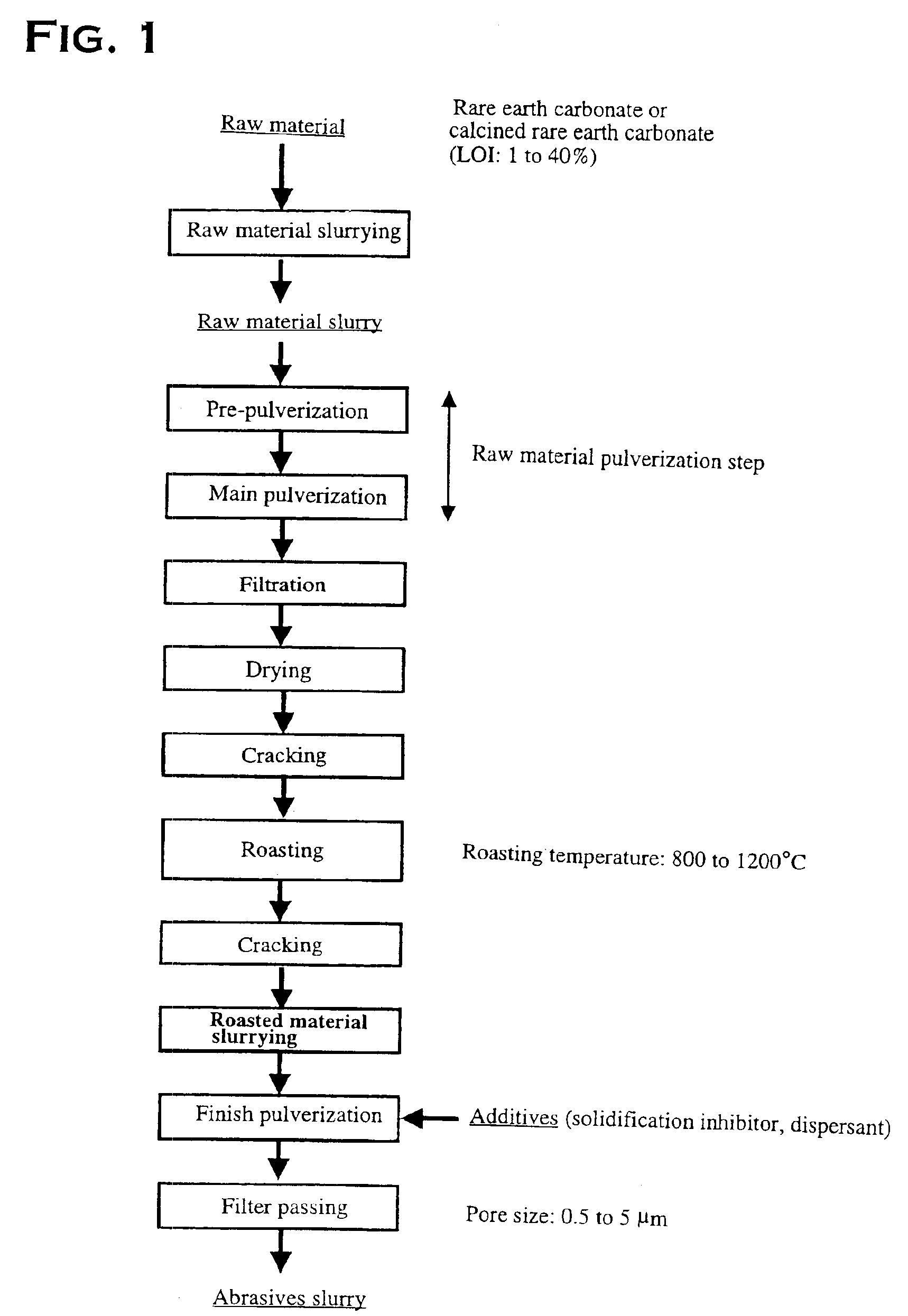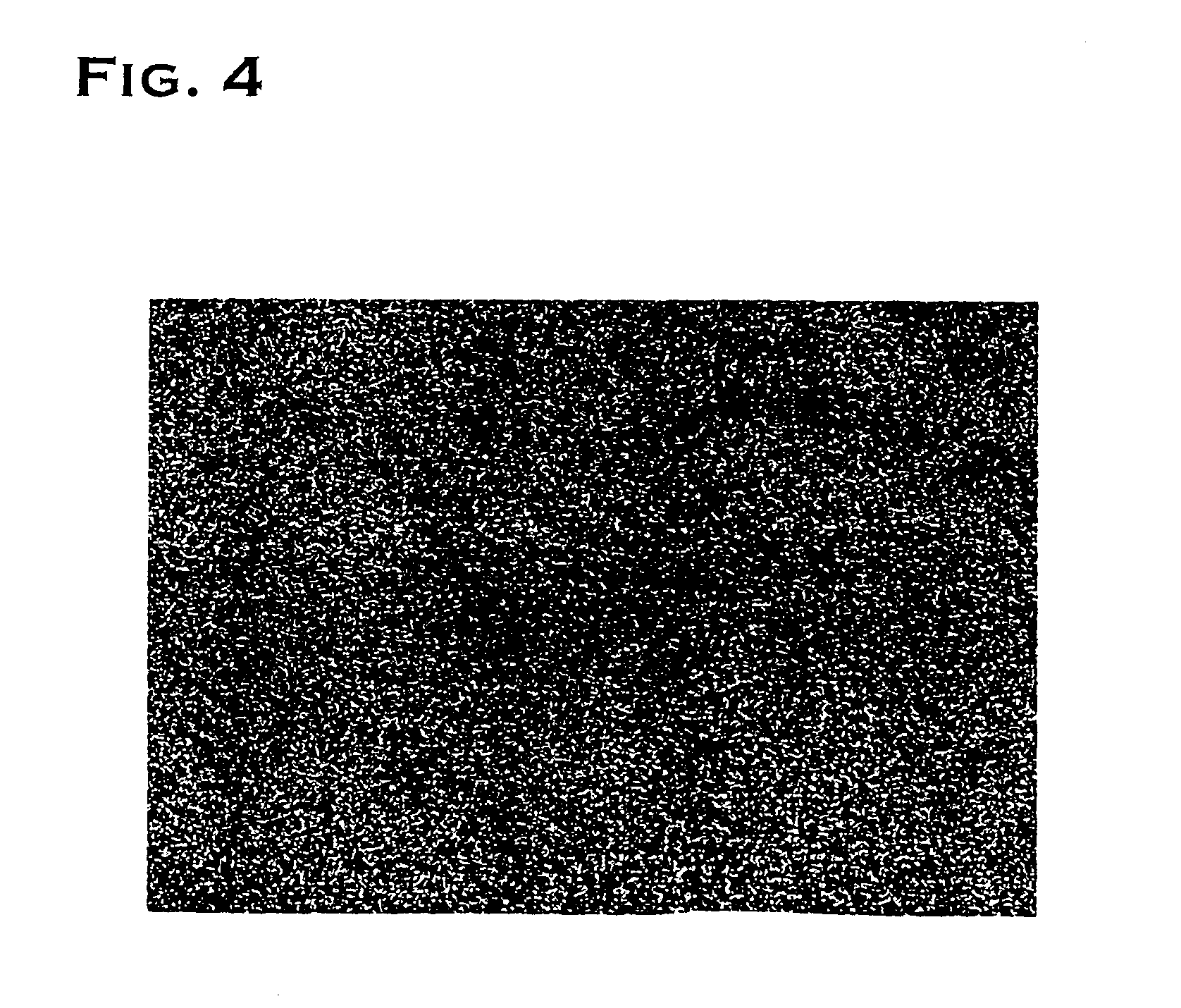Cerium-based abrasive material slurry and method for producing cerium-based abrasive material slurry
- Summary
- Abstract
- Description
- Claims
- Application Information
AI Technical Summary
Benefits of technology
Problems solved by technology
Method used
Image
Examples
first embodiment
[0058]Manufacturing steps of a cerium-based abrasive in this embodiment are same as that of FIG. 1. In this embodiment, after a pre pulverization and a main pulverization a raw material is dried and cracked. And after roasting a finish pulverization is performed, additives are added, filter passage is performed to manufacture an abrasive slurry. In addition, although an abrasive slurry is directly manufactured in this embodiment, manufacture of an solid cerium-based (powdered) abrasive is possible by drying a slurry after filter passage. In addition here, a final fluorine concentration of an abrasive slurry is adjusted by existence of fluorination treatment, and by adjustment of a roasting temperature.
[0059]: Raw material used here is a rare earth carbonate having following characteristics.
[0060]
TREO (based on dry weight)67%Cerium oxide concentration (based on TREO)58%Fluorine content (based on TREO)0.16% Water content (loss on drying method)30%Loss on ignition (based on dry weight...
second embodiment
[0076]This embodiment has fundamentally same details as in the No. 1 of First Embodiment, but each step of the main pulverization step, the roasting step, and the finishing pulverization step was modified to manufacture an abrasive slurry. Three-pass pulverization was performed as the main pulverization here using a beads mill using zirconia ball with a diameter of 1.0 mm (5.2×10−4 cm3 / piece) as pulverizing media. When a particle size distribution was measured for the raw material after the main pulverization, 0.483 μm of cumulative 10% particle diameter (D10), 1.027 μm of cumulative 50% particle diameter (D50), and 2.138 μm of cumulative 90% particle diameter (D90) were obtained, and 5.60 μm of maximum particle diameter (Dmax) were obtained. And in roasting step, temperatures were set to 750° C., 950° C., 980° C., 1020° C., and 1050° C. Furthermore, in the finishing pulverization, a planet ball mill (number of turn: revolution 200 rpm, rotation 300 rpm) using zirconia ball with a d...
third embodiment
[0081]As in the Second Embodiment, each step of a main pulverization step, a roasting step, and a finishing pulverization step was modified to manufacture abrasive slurries. In a main pulverization here, a beads mill using zirconia ball with a diameter of 0.65 mm (1.4×10−4 cm3 / piece) as pulverizing media was used, and 2 pass-pulverization was performed by a passage method with an amount of 2 L / minute of liquid delivery. When a particle size distribution was measured for the raw material after the main pulverization, 0.523 μm of cumulative 10% particle diameter (D10), 1.203 μm of cumulative 50% particle diameter (D50), and 2.335 μm of cumulative 90% particle diameter (D90) were obtained, and 6.85 μm of maximum particle diameter (Dmax) was obtained. And a roasting temperatures were unified to 980° C. in a roasting step, and in a finishing pulverization, a beads mill using zirconia ball with a diameter of 0.4 mm (3.4×10−5 cm3 / piece) as pulverizing media was used to perform 2 to 8 pass-...
PUM
 Login to View More
Login to View More Abstract
Description
Claims
Application Information
 Login to View More
Login to View More - R&D
- Intellectual Property
- Life Sciences
- Materials
- Tech Scout
- Unparalleled Data Quality
- Higher Quality Content
- 60% Fewer Hallucinations
Browse by: Latest US Patents, China's latest patents, Technical Efficacy Thesaurus, Application Domain, Technology Topic, Popular Technical Reports.
© 2025 PatSnap. All rights reserved.Legal|Privacy policy|Modern Slavery Act Transparency Statement|Sitemap|About US| Contact US: help@patsnap.com



